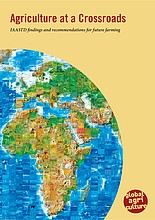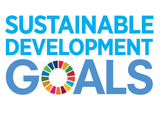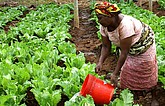Agriculture at a Crossroads - Business as Usual is Not an Option!
Why should up to 783 million people on our planet be going hungry while 2.5 billion are suffering from the ill effects of overweight and obesity? In 2021 more grain was harvested than ever before: 2.8 billion tons worldwide. Despite this record-breaking harvest, only 42.2% was used to feed people. The rest was used to feed livestock, fill our petrol tanks, support industrial production processes or was simply wasted. Our global food system is one of the most significant contributors to climate change, loss of biodiversity, pollution and water shortages as well as preventable disease, poverty and injustice.
On behalf of the United Nations and the World Bank, in a four-year-process, more than 400 scientists summarised the state of global agriculture, its history and its future. The outcome was the International Assessment of Agricultural Knowledge, Science and Technology for Development (IAASTD). The findings are uncomfortable and alarming: providing a warning on the misleading ways of the past and showing new ways forward. This website makes the IAASTD’s findings available by topics, and offers all reports as well as updated figures, background information and news.
15/02/24 +++ Global organic farmland up 26% in 2022, reaching 96 million hectares +++ NEW
20/12/23 +++ What the “Food COP” had in store for food and agriculture +++
12/10/23 +++ GHI: Multiple crises are hampering fight against hunger +++
15/09/23 +++ Six of nine planetary boundaries crossed, scientists warn +++
02/08/23 +++ Overshoot: We have exceeded our natural resource budget for 2023 +++
12/07/23 +++ Up to 783 million people in the world are suffering from hunger +++
16/06/23 +++ HLPE report calls for action to reduce inequalities in food systems +++

8/23: August 2 marks Earth Overshoot Day this year – the day humanity has used up the natural resources Earth can regenerate in a year, according to data from Global Footprint Network, an international sustainability think tank. The date is calculated each year by contrasting the world’s demand on nature (ecological footprint) with the biocapacity - forests, pastures, cropland and fisheries as well as the planet’s ability to replenish resources and absorb waste, including emissions. In 2020, the impact of the Covid-19 pandemic had pushed the date back to mid-august but now we are back on the wrong track. More
HLPE report on reducing inequalities for food security and nutrition
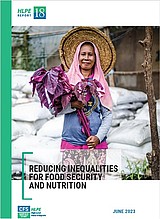
6/23: The High Level Panel of Experts on Food Security and Nutrition (HLPE) of the Committee on World Food Security launched a new report on “Reducing inequalities for food security and nutrition”. Despite progress in reducing global poverty, food insecurity and malnutrition over the past decades, the world continues to grapple with the alarming increase in hunger and malnutrition, the panel warns. Inequalities in food security and nutrition, between countries and regions and within countries, communities and households, exist worldwide. They have a devastating impact on communities, diminishing people's life chances, hampering productivity, perpetuating poverty, and impeding economic growth. The HLPE provides a conceptual framework for assessing inequalities in food security and nutrition, the inequalities within and outside food systems that underpin them, and their systemic drivers. Read our summary here.
IAASTD report calling for radical changes in agriculture turns 15
4/23: The way the world grows its food has to change radically to better serve the poor and hungry if we are to cope with a growing population and climate change while avoiding social breakdown and environmental collapse. That was the message of the press release published on April 15th 2008, announcing the adoption of the International Assessment of Agricultural Science and Technology for Development (IAASTD). On behalf of the UN and the World Bank, more than 400 scientists had summarised the state of global agriculture, its history and its future in a 4-year-process. The authors of chapter 3 of the Global Report provided a great overview of the current state of knowledge about global agriculture. Read their 10 main concerns and lessons here.
New book: Transformation of our food systems
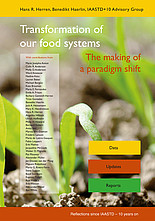
Over the past decade, a new food system narrative has been firmly established, distinctly different from the post-war chemical narrative which still dominates mainstream farming. Nothing less than a real paradigm shift for agriculture, nutrition and food systems emerged, inspired to a great extent by the International Assessment of Agricultural Knowledge, Science and Technology for Development (IAASTD) that was finalised in April 2008.
The new book "Transformation of our food systems – the making of a paradigm shift" takes stock of what has been achieved through and since the IAASTD report. It compiles essays summarizing a range of highly regarded international scientific and political reports that have been published after IAASTD. Together with topical papers from former IAASTD authors they are highlighting what has been achieved and what still needs to be done.
Brochure: IAASTD findings and recommendations for future farming
Business as usual is not an option, if we want to reduce hunger and poverty, improve rural livelihoods and achieve environmentally, socially and economically sustainable development for all. This was the message of the “International Assessment of Agricultural Knowledge, Science and Technology for Development” (IAASTD). The new brochure “Agriculture at a Crossroads” presents the report’s main findings with updated facts and figures, charts and maps and the latest scientific insights. The 52-page-brochure covers topics such as hunger and health, meat and animal feed, industrial and small-scale farming, agroecology, climate and energy, soil fertility and land grabbing. It connects the IAASTD’s findings to the UN Sustainable Development Goals and contains an interview with IAASTD co-chair Hans Herren.
Download the brochure here.
Five years into the SDGs: Goals for a world without hunger and poverty
9/20: September 25th marks the 5th anniversary of the 2030 Agenda for Sustainable Development. In 2015, the 193 UN Member States adopted 17 Sustainable Development Goals (SDGs) and a set of 169 targets that aim to end poverty and hunger in all their forms by 2030 while protecting the environment. Eliminating hunger is a key issue of the new agenda. Goal 2 promises to „end hunger, achieve food security and improved nutrition and promote sustainable agriculture”. It has targets on ending hunger and malnutrition by 2030, doubling the agricultural productivity and incomes of small-scale farmers, ensuring sustainable food production systems and resilient agricultural practices, and maintaining the gentic diversity of seeds, plants and animals.
IPES-Food presents new vision for sustainable food systems in Europe
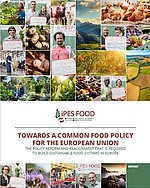
2/19: A group of leading food experts have mapped out a vision for reforming European food systems in a new report launched in February. EU food and farming systems require a fundamental change of direction in order to address climate change, halt biodiversity loss, curb obesity, and make farming viable for the next generation, says the International Panel of Experts on Sustainable Food Systems (IPES-Food). The expert panel proposes a “Common Food Policy”, a policy framework setting a direction for the whole food system, realigning the various sectoral policies that affect food production, processing, distribution, and consumption, and refocusing all actions on the transition to sustainability.
Read more or download the report.
Symposium: Scale-up agroecology to transform food systems
4/18: It is necessary to scale up agroecology in order to transform food and agricultural systems and achieve the Sustainable Development Goals (SDGs). This was the message of the 2nd International Agroecology Symposium that was hosted by FAO in Rome. The event brought together more than 700 participants with representatives from 72 governments, around 350 civil society and other non-governmental groups, and six UN organisations. It builds on the first agroecology symposium held in 2014 at FAO, followed by a series of regional meetings, which highlighted the important role agroecology can play. Read more here
If we were to divide the total global surface area of arable land by the number of people living on the planet, each person would get 2000m². It is on this piece of land that everything Mother Earth supplies you with must grow: wheat, rice, potatoes, fruit, vegetables, oil, sugar… not to mention all the animal feed that does not stem from meadows and pastures. Visit the website of this project to find out what your 2000m² would look like if they were to represent the global situation and to get a sense of your own role in global agriculture.

